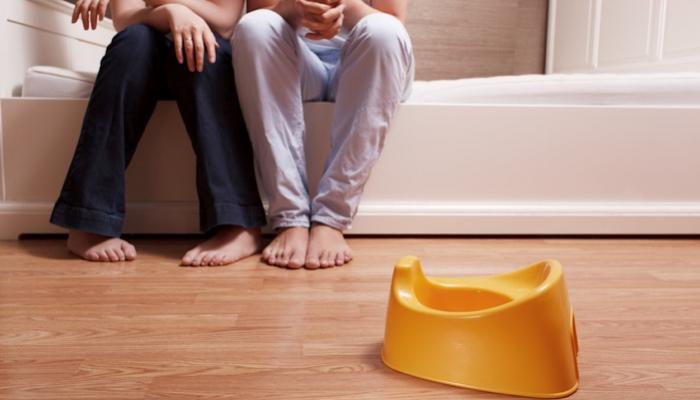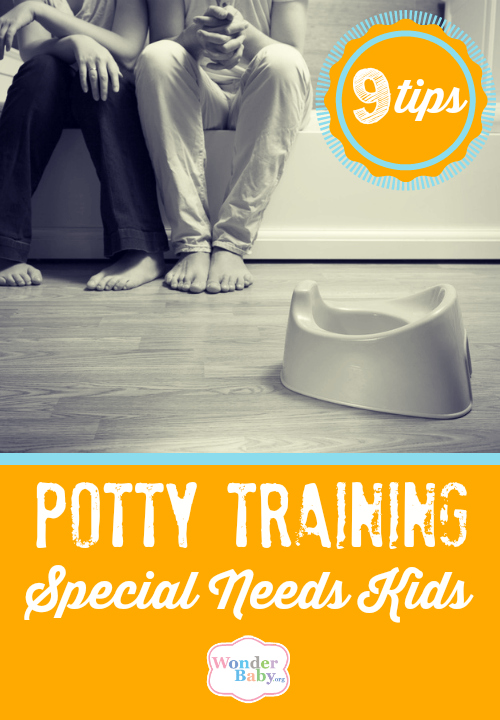Potty Training Your Special Needs Child

Potty training a child is difficult under any circumstances, but when your child has special needs you will need to take their abilities and delays into consideration before you can begin potty training.
This may at first seem like a daunting task and I’m sure you’re starting to worry that your child will never move out of diapers, but if you take your time and prepare your child you can achieve potty training success!
The first step in potty training is to familiarize yourself with the basics behind the task. You may want to begin by reading our article on potty training for general parenting concerns.
When you’ve got those basic concepts down (and I’m sure you’re already aware of which tactics will work for your special child and which won’t), you’ll be ready to decide if your child is ready to begin potty training.
When Is My Child Ready to Begin Potty Training?
There are a few signs that will let you know that your child is physically ready for potty training. For example, you may notice that your child’s diaper stays dry for about two hours at a time during the day, their bowel movements come at regular times, and (usually) they stay dry through the night.
For normally developing children this will usually happen between the ages of two and slightly after their third birthday.
But it’s important to remember that children with special needs move at their own pace and forcing potty training on a child who just isn’t developmentally ready will not only be a waste of time, it will also be a horrible experience for both you and your child.
How will you know when your child is developmentally ready for potty training? Here are some signs to look for…
|
Of course, not all kids will be able to do all of these things, but you should have a good feel that your child is on the right track developmentally to handle potty training. If you feel your child is both physically and developmentally ready to begin potty training, then it’s time to get started!
Some Tips to get You Started
- Begin by keeping a record of your child’s dirty diapers. Note in a notebook or on a chart when your child urinates or has a bowel movement through out the day. When you begin potty training you’ll have a good idea of how often your child will need to go and when.
- Tell your child that you will be potty training. It’s good to keep your child informed and involved of what’s going on. If you can, get them to help you with their diaper changes and describe everything you are doing so that they are very aware of the process.
- Get your child interested in the toilet. Before you begin potty training, get your child in the bathroom and show them around. Let them touch the toilet (I know, it’s yucky, but if your child is visually impaired they need to know what they’re up against!) and hear it flush. Explain what the toilet is for and then show them how to wash their hands. Some kids really love washing their hands in the sink and this in itself can become a fun reward for using the potty.
- On potty training day, be sure to drink plenty of fluids. A hydrated child will need to use the potty more often and will have a better concept of when their bladder is full.
- Set a potty timer to go off every hour after your child uses the potty. When the timer goes off, it’s time to go to the potty. This will keep both you and your child aware of the potty and it will take the pressure off of you. You’re not telling your child to use the potty, the timer is!
- Don’t wear diapers during potty training. Diapers whisk wetness away from the skin. You want your child to be as aware as possible of the discomfort of being wet so that they can learn to use the potty before an accident happens.
- Get them on the real toilet as soon as possible. Rather than working on potty training in a small potty seat that sits on the floor, try to get your child on the real toilet as soon as you can. This will help them understand where they are heading (your goal is to get them on that toilet eventually anyway, isn’t it?) and will solidify the concept of “toilet” for them. A good potty seat that sits directly on the toilet is the Baby Bjorn adjustable toilet seat.
- Support your child’s feet while on the potty. If your child is not using a small potty on the floor, make sure their feet are not dangling from the big toilet. It may be hard for your child to balance on the toilet, especially if they can’t see, so give them as much physical support as possible. Consider installing handicap rails if you think it will help your child.
- Always reward success! When your child does use the potty successfully be sure to praise them and hug them! Also have a treat of some sort nearby that they only receive after using the potty. You can even set up a tactile chart using glue to draw small squares and fuzzy stickers so your child can see how many times they’ve used the potty successfully.
Communicating the Need to Go
One of the biggest difficulties in teaching a special needs child to use the toilet is probably communication. If your child is physically ready and for the most part developmentally ready, but they can’t verbally tell you when they need to use the potty, then how will you ever know? Trying to anticipate their needs without communication would be difficult at best and most certainly would lead to quite a few unintended accidents.
Here are a couple of ideas to help you get around the communication problem:
- Use sign language.
We taught our son some simple signs when he was very young. One sign he picked up right away was diaper. When it was time to start potty training he still wasn’t using much functional language and he couldn’t walk to the potty himself, but since he could sign when his diaper needed changing we knew we could work with that little bit of language to help him tell us when he needed to go. Learn more about teaching visually impaired babies sign language. - Use tangible symbols.
If your child doesn’t have the coordination for signs, you may want to try using tangible symbols. Keep these symbols handy so your child can communicate their need to use the potty by simply touching the symbol. A good symbol to use for the bathroom is a piece of remnant tile. Most bathrooms have tile in them somewhere and the tile will feel reminiscent of the toilet itself.
If you’re feeling adventurous consider exploring other popular potty training methods, such as Oh Crap! potty training or 3 day potty training. These approaches aren’t for everyone, but they can give you some good ideas if you feel you aren’t making progress.
Good luck with your potty training and remember that this is an adventure for both you and your child. It won’t be easy and there will be a lot of accidents along the way, but the reward sure is worth it!
Read this article in Arabic: قراءة هذا المقال بالعربية

Related Posts

Eye Conditions and Syndromes, Visual Impairment
Neuralink Announces Plans to Restore Sight to the Blind with Brain Chip
Elon Musk’s company Neuralink has announced plans to begin human trials of its new “Blindsight” brain chip by the end of 2025.

Special Needs
5 Spring Cleaning Tips for Families of Children with Disabilities
Spring cleaning is an opportunity to create a more accessible, organized, and supportive space for your child with disabilities. Declutter, deep clean, and refresh!

Visual Impairment
The Gift of Understanding: How a Young Child Helps His Blind Father Navigate Life
When a parent is blind, it’s natural for people to wonder how their sighted child will adapt. Will they struggle to understand their parent’s needs? Will they feel burdened by...